I like to keep my eye out for new and upcoming games from designers and often reach out to those I have interviewed in the past to see if they have anything new and interesting upcoming. One guy that I literally hound often is John Poniske. He has designed many great games with some of his finest being Hearts and Minds: Vietnam 1965-1975 (2010, Worthington Games), King Philip’s War (2010, Multi-Man Publishing) and Lincoln’s War (2013, Multi-Man Publishing). I have actually interviewed John 5 previous times, including the following titles: Belmont: Grant’s Baptism of Command, Plains Indian Wars, Blood on the Ohio: The Northwest Indian War, 1789-1794, Revolution Road and The Berlin Airlift. When I heard about his upcoming World War I wargame focused on the Marines at Belleau Wood, I was very intrigued and immediately contacted him. He was of course gracious enough to take the time to answer my questions and I must say that I am really looking forward to this game. Please keep in mind that the artwork and layout of the components are not yet finalized and are only for playtest purposes at this point. Also, as the game is still in development, details may still change prior to publication.
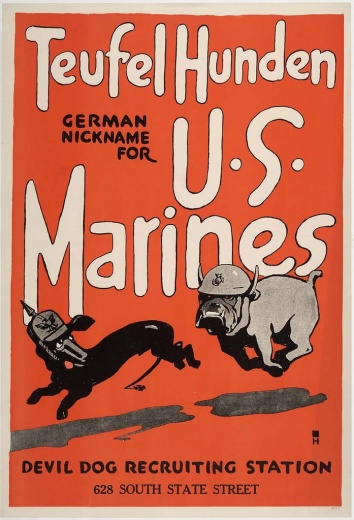
Grant: First off John, tell us about your co-designer John Poniske on this project. Is this your son? How do the two of you work together?
John: Yes, John is my son, also a Marine veteran and a highly intelligent computer guru who cut his teeth on war games. He often employs his impressive intellect by offering incredibly cerebral movie critiques. He has an uncanny knack for explaining the finer details of movie production. It has been a pleasure working with him on this project and I hope we will do so again in the future.
Grant: What is the history behind The Devil Dogs of Belleau Wood?
John: In short the battle was used in a Marine publicity blitz. Not to say that the Marines had not succeeded in achieving their objectives but the battle was simply blown out of proportion. This was done to impress upon the public the essential nature of the Marine’s elite fighting force. We learned a lot in researching the battle. The Marines did indeed plug a hole left open by fleeing French soldiers during the final German offensive of the war. Paris lay no more than 50 miles from the advancing German line. On the other hand, the veteran German units that spearheaded the offensive were blown. Many had less than 50% fighting effectives and German supply lines were stretched to the point of breaking. The battle in question pitted fresh fully equipped and well rested American troops against worn-out, underfed and disillusioned Imperial troops. It is true that the Marines were outnumbered and absorbed more casualties at Belleau Wood than in all their previous conflicts combined. They also faced a greater number of veteran machine gunners and suffered beneath more effective artillery barrages. But taking all of this into account, Belleau Wood remains more of a skirmish when compared with the other great battles of the Great War. That said – Belleau Wood remains the seminal foundation for the fighting reputation of the United States Marine Corps.
An official German report from the period classified the Marines as “vigorous, self-confident, and remarkable marksmen …”
Grant: What sources were your main reference for the design? Any great books on the subject?
John: In answer to this question, I will simply give you the Bibliography players will find in the rules.
Chateau Thierry and Belleau Wood 1918, David Bonk, Osprey Publishing, London England, 2007.
 Devil Dogs: Fighting Marines of World War I, George B. Clark, Presidio Press, Novato, CA 1999.
Devil Dogs: Fighting Marines of World War I, George B. Clark, Presidio Press, Novato, CA 1999.
The Devil Dogs at Belleau Wood: US Marines in World War I, Dick Camp, Zenith Press, Minneapolis, MN 2008.
His Time in Hell: A Texas Marine in France, Warren R. Jackson, Presidio Press, Novato, CA 2001.
Miracle at Belleau Wood: The birth of the Modern U.S. Marine Corps, Alan Axelrod, Lyons Press, Guilford, CT, 2007
Suddenly We Didn’t Want to Die, Elton Mackin, Presidio Press, Novato, CA 1996.
There are also lots of web resources that were used.
2nd Engineers at Belleau Wood, The Doughboy Center http://www.worldwar1.com/dbc/ct_bw2eng.htm
Americans Take Belleau Wood, WWI Document Archive https://wwi.lib.byu.edu/index.php/Americans_Take_Belleau_Wood
Chateau Thierry: The battle for Belleau Wood, The Doughboy Center http://www.worldwar1.com/dbc/ct_bw.htm
First World War.com http://www.firstworldwar.com/source/belleau_daniels.htm
Marine Corps Association and Foundation: Belleau Wood https://www.mca-marines.org/gazette/2015/11/belleau-wood
Marine’s Official Website: 5th Marine Regiment, 1st Marine Division http://www.1stmardiv.marines.mil/Units/5TH-MARINE-REGT/
Marine’s Official Website: 6th Marine Regiment, 2nd Marine Division http://www.6thmarines.marines.mil/
Second Division – Second to none http://2nd-division.com/
U.S. Army Chemical Corps Historical Studies: Gas Warfare at Belleau Wood http://bl-libg-doghill.ads.iu.edu/gpd-web/historical/acchs/acchs1.pdf
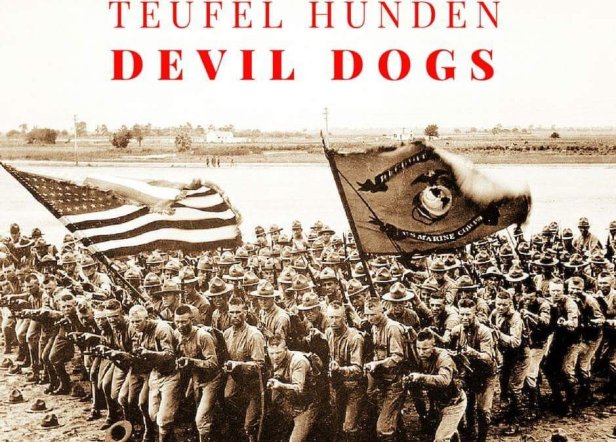
Grant: I also noticed that you used several historical consultants who specialize in the history of the WWI Marine Corps. How was your experience with them? How did they consult on the design? Did they ever play the game?
John: Yes, early on I received a referral to three Marine historians from a Facebook mention of the game in progress: Steven Girard – WWI Marine Corp Archivist / Historian who is currently in Europe acting as a WWI military history guide; Kevin Seldon – WWI Marine Corps Historian/Author (currently working on a three volume work on the battle); Mark Waddington – Professor at Lake Washington Institute of Technology. We also received advice from Stèphane Sènèchal – French WWI Historian. The first three have been sent the components to the game. We were blessed to have these knowledgeable gentleman critiquing the game as it progressed.
The term “Devil Dog” has its origins at Belleau Wood. It was in a dispatch from the German front lines to their higher headquarters explaining the current battle conditions that described the fighting abilities of the new, fresh Americans as fighting like “Teufel Hunden” or “Hounds from Hell.”
— MSG Phil, US Marine Corps.
Grant: What drew you to this subject as a wargame? What elements from history did you work very hard to incorporate into gameplay?
John: Ah, that’s two separate questions. First the “Marine” element. As Marine veterans, both John and I were taught in boot camp that Belleau Wood was one, if not the key event in Marine Corps history. At some point he e-mailed me a story about the upcoming centennial anniversary of the battle and I suggested we create a game on the subject. He agreed. We decided that A) Machine guns must play a very large role, B) Order confusion must also play a part, C) Artillery and Gas must play disruptive roles and, D) Game casualties must reflect the horrendous historical casualties in the field.
Grant: The game is Card Driven. How many cards are used in the design? Are opponent events triggered by playing their event card for Ops points?
John: Each player has at his disposal a 30 card faction-specific deck. Card hands depend on the scenario played and the number of sectors in that scenario plus one additional card. For example, if a scenario uses all four sectors – player hands would be 4+1 or five cards. Cards do contain orders that trigger opponent’s events, orders such as: Hesitation, Misdirection and Underfed. However there are no Ops points involved. You may be confusing the card number in the upper right corner of the cards with Ops points when in fact these are barrage deviation numbers. More on that later.
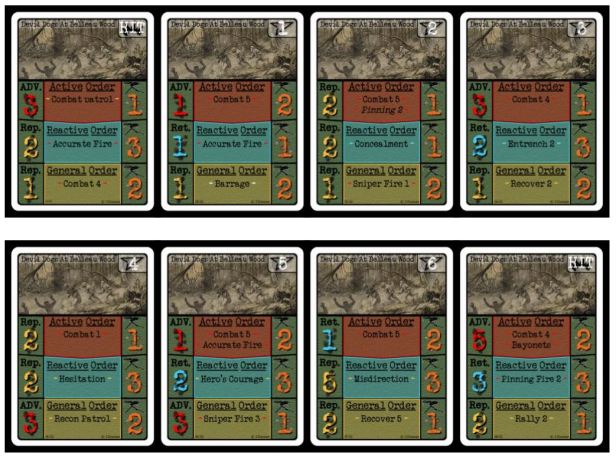 Grant: How are the cards used?
Grant: How are the cards used?
John: Each player has a player aid that lists and describes the 25 different keyword actions found on the cards. I won’t list them all but examples of a few are: Accurate Fire, Barrage, Bayonets, Hidden Machine Guns, Shell holes, Pinning Fire X and Rally X. The order Combat X is the order that commits all units within an X hex range to simultaneous combat. No Ops points are used. Orders are simply given and acted on based on the card used, the order given and the sector chosen.

Grant: I read where “the game is unique in that it captures the tension and high rate of casualties without ever casting a single die”. What does this statement refer to and why is it true?
John: My son wanted to create a different type of war game, one that did not rely on dice and CRTs. To that end, we developed an order system whereby players choose one of three order bands on each card. Each order band directs movement, machine gun casualties (chosen by the firing player – within line-of-sight of the firing units) and two distinct keyword orders. Although combat is intermittent based on the orders given, casualties rapidly mount due to the mandatory machine gun casualties taken in every sector in every turn.
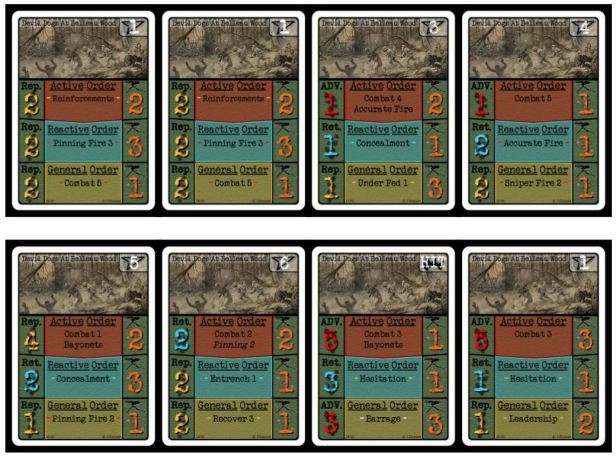
Grant: I also read where “strategy lies more on planning and issuing orders as the active or reactive player”. What does this statement mean?
John: As previously stated, players issue orders based on the card they choose to use in each sector, however their choice is based on the player’s battlefield initiative. This in turn is based on casualties taken. If a player has the initiative as indicated by the Initiative Track he may choose an Active or General order. If a player does not have the initiative he must choose between a Reactive or General order. Active orders force units to advance and allow more mobility. Reactive orders sometimes order units to retreat but often allow for more protection and increased opportunity to rally. General orders allow for a milder mix of both types of orders. Barrage orders are scattered across the three types of orders.
Grant: What is the scale of the game?
John: The map covers approximately one square mile. Each hex is about 150-180 meters across. Unit scale is company level – one unit per hex.
Grant: What is the force structure for each side and how do the two sides units compare and differ?
John: Force structure is company/battalion/regiment. Forces differ in that the two Marine regiments and their supporting U.S. and French Army units have considerably fewer units than the elements of the five German divisions they face. A balancing act comes into play here. The Americans were fresh, fully manned, well-supplied and possessed of high morale. In comparison, the Germans were pretty much played out. Units were under-supplied, severely undermanned (some companies had been reduced to 30 men) and suffered from declining morale. The Germans trained both assault and defensive units. Both are represented in the game. Offensive units have a four-step capability the same as Allied units, however most assault units enter the game already down one or two steps. Defensive units are 3 step units. All allied units are four step units and as such are more difficult to eliminate.
Grant: What different unit types are there?
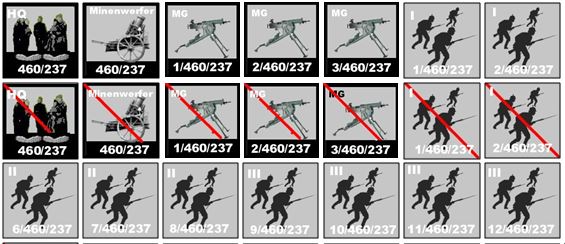
John: Each regiment has a Headquarters unit, any number of infantry units and a lesser number of machine gun units along with regimental mortar units. Allied and German Machine Gun and Mortar types are distinctly different and depicted as such on the playing pieces but for game purposes have the same effect regardless of the side played. In addition, the Americans have what was called 1” artillery. A light field piece borrowed from the French that for all intents and purposes acts as a machine gun in the game. There is a small contingent of French that offer an HQ, Infantry and Machine Gun units. Finally there is a larger contingent of US Army units that include HQ, Infantry, mortar, machine gun and engineering units. The engineer units have the same capability as infantry.
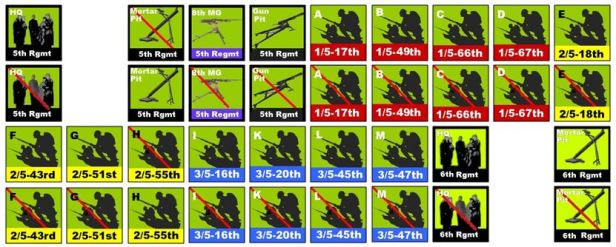
Grant: Back to the cards for a second. How is each player’s hand size determined? What was the logic behind this choice?
John: As previously explained, hand size is determined by the scenario and the number of sectors involved plus one additional card. Our logic was based on A) Offering enough choice to the player that he has a variety of options and B) Limiting those options to prevent paralyzing indecision. Some of that indecision is removed by having initiative limit player choice.
“The deadliest weapon in the world is a Marine and his rifle.”— General John J. Pershing
Grant: What is the Plot Sector Cards Step and what does this represent? Why is this a good way to use the cards? How does planning relate to the use of these cards?
John: Following card draw, this is the second step in each turn. It forces players to decide where to allocate their limited order resources. One card must be committed to each sector. We believe this is a good use of cards because it is unique. What orders are available is dependent on the battlefield situation but random chit draw may bollix up a player’s plan.
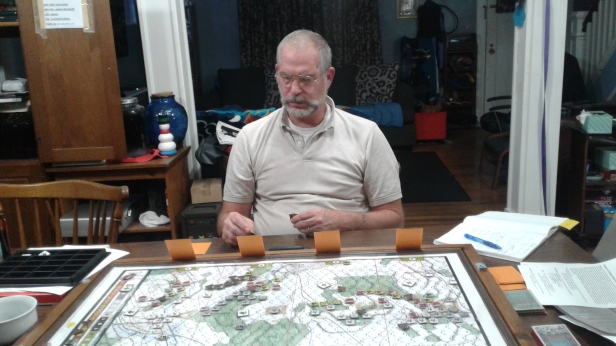
Grant: How exactly does the initiative phase work and what does it represent from the history?
John: I am very fond of this mechanic. To my knowledge it is completely unique to war-gaming. Initiative, as previously stated, is based on casualties. However, there are different stages of initiative, seven to be exact. Depending on where players find themselves on the Initiative Track at the beginning of a turn determines the “Initiative Mix.” The initiative mix consists of a varying number of German, Allied and Stalemate chits. The better one’s initiative, the more of one’s chits are in the mix. When initiative is closer to even, Stalemate chits appear. Once the mix is determined. Players randomly draw and place a chit in each sector. So you see, even if the Initiative Track shows you have momentum, you cannot be absolutely certain that the chits will fall your way and the order card you played may well be wasted due to lost initiative in a particular sector. When the dreaded Stalemate chit falls in a sector neither player holds the initiative and both must use the General Order on the card they assigned.

Grant: What is an order indicator and how are they used to win initiative in each sector? What do these counters look like?
John: Order indicators are not used to win initiative but to indicate whether or not the player will use their Active or General order if they hold initiative in a sector OR their Reactive or General order if they do not hold initiative. The Allied chit is the Marine emblem – the Eagle, Globe and Anchor. The German chit is a Maltese Cross. Active orders are indicated by a red band, Reactive by a Blue band (the chosen band is placed facing one’s opponent. If the General order is chosen, the player flips the indicator over to its yellow side.
Grant: Have to ask. I know that the Germans love their sausages, but what is a Sausage Barrage? How is gas used in barrages?
John: A Sausage Barrage is not a bologna blowout. It is an accurate artillery barrage where the targeted hex does not deviate. The term sausage comes from the Allied nickname for the German observation balloons floating all along the German lines. The Allied version of this order is Recon’d Barrage. A Gas barrage order works differently than a typical barrage. First a target hex is chosen. Next a card is drawn and the deviation number in the upper right corner of the card is noted and acted on. Next all units in or adjacent to the hex lose one step and must retreat the shortest distance toward the friendly side of the board. The gas marker remains and acts as a hindrance in the following movement phase.

Grant: How does combat work and what are unit combat strengths indicative of?
John: We determined to make combat as simple as possible. To do so we eliminated any combat charts and relied strictly on adding combat strength within the required combat X area (X standing for the hex range indicated on the card) comparing the two and applying casualties based on the health of a unit and the defensive position he holds. Defensive positions include woods and urban hexes. Units in defensive positions take two casualty hits before they lose a step. Casualties are determined by opposing players but are limited to A) the indicated combat range, B) Line of sight and C) the target priority chart found on the Player Aid. At the end of combat, the player absorbing more casualties moves the initiative marker on the Initiative Track the difference in steps between his and his opponent’s casualties. For example: Germans have lost 12 steps, Allies have lost 10 steps. The Initiative marker is advanced two spaces in the Allied direction.
Grant: What role does the Target Priority Chart play in combat?
John: It forces players to fire first at units in the open before they would fire at units in defensive positions as soldiers in the field logically would do. It may seem illogical at first that the priority chart indicates infantry targets over the more powerful heavy weapons units but we found that if this was not done machine guns were always targeted and were too rapidly removed from play.
Grant: What is a Falter Token and how do they affect units?
John: A Falter Token is a red translucent disc that acts as an intermediate step loss. If hit again, the disc would be removed and the unit flipped to its damaged side. Falter Tokens do not affect a unit’s strength but does make a player more leery of placing it in harm’s way. A rally X order will regain X number of steps which allows a player to remove discs if it fits into his plans. You did not ask about Pinning. [Editor’s Note: Let me rectify that immediatley. John, what is Pinning?] Pinning Fire X indicates that a number of yellow discs are placed on enemy units within line of sight. Pinning has no effect on a units steps but it does halve its firepower and means a unit may not move. These discs too may be removed by a Rally X order.
Grant: What is the difference between German Assault units and Defensive units?
John: Assault units were trained to constantly be on the offensive. Their tactics were designed to constantly advance. They were periodically replaced by units trained specifically to be defensive minded. This is reflected in the game by the unit’s HQ sporting either a bayonet (Assault) or sandbags (Defense). At this time in the war. The German Assault units were sorely depleted and play only a minor role in Belleau Wood.
Grant: What do the counters look like? Can you show us a few examples and explain their layout and information?
John: Again we wanted to simplify play as much as possible. Each unit consists of a silhouette and unit identification. All HQs, infantry and Engineer units possess one Combat Strength (CS) and all Machine Guns & 1” artillery two CS, so showing strength is unnecessary. Mortars and Artillery have a different set of rules. Movement is indicated by the card order so that is not necessary.

Grant: What is the map like? Who is the artist?
John: The map covers the relatively small area in which the battle took place. It consists of urban areas, woods, and topographical lines. The artist is the famed ACW cartographer, Rick Barber. The map here shown is his second version. The final version will contain more detail.

Grant: What are the available scenarios?
John: There will be six scenarios – three training scenarios and three historical scenarios. The first training scenario will be a Kickstarter bonus. They are Training scenario A – Le Mare’s Farm; Training scenario B – Turning the Tide; Training scenario C – The Bouresches Counter-attack; Historical Scenario #1 – The Belleau Woods Offensive; Historical Scenario #2 – Doughboys on the Line; Historical Scenario #3 – The Final Push.
Grant: How long does each of the scenarios take to play?
John: Scenarios last between one to four hours. However this is a unique approach to war-gaming and there will be a learning curve.
Grant: In general what are the victory conditions?
John: Points are awarded for taking objectives, proximity to objectives and a player’s Initiative position at the end of the game.
 Grant: What do you feel the design excels at? What are you most pleased with?
Grant: What do you feel the design excels at? What are you most pleased with?
John: The design excels at presenting a very real WWI feel – including order confusion, Machine gun mastery and massive casualties. I am most pleased that I have had the opportunity to spend more time with my son and create what I consider a stellar design.
Grant: What has been the reaction of the playtesters?
John: We have had a number of different play-testers take the design for a spin. To a person, there was initial confusion because every person entered into the game with set perspectives on how a typical wargame is supposed to work and Belleau Wood is not a typical war game. However, once the unique aspects of the design were understood, each player was amazed at how smoothly the mechanics mesh and how tense and bloody play can be.
Grant: What is the schedule for the game’s release?
John: Worthington Games has committed to beginning a Kickstarter Campaign for the game late this summer. The idea from the very beginning was to have the design completed, play-tested and published before the end of 2018, the centennial anniversary of the conflict.
Grant: How was it working with the publisher?
John: From my initial presentation all the way through development, Grant and Mike Wylie at Worthington have been open and accepting of the design and its radical approach. They admitted early on that they were considering doing more hex based games and TheDevil Dogs of Belleau Wood fit nicely into their schedule. Grant showed strong enthusiasm during his test play. I am very excited to see this title presented using Worthington’s increasingly fine components. Thanks for giving me the opportunity to give your readership an advance taste of TheDevil Dogs of Belleau Wood.

Thanks for your time John and for giving us such great detail on the design for The Devil Dogs of Belleau Wood. I know that I will be looking forward to this one. As I have read up on the lore of this battle, and some of the history from various online resources, it is apparent to me that this battle was a major win for the Marines and set them on their modern trajectory as some of the finest fighting men in the world. One final quote from General John Pershing who said, “the Battle of Belleau Wood was for the U.S. the biggest battle since Appomattox [Court House] and the most considerable engagement American troops had ever had with a foreign enemy.” Thanks to John and John for bringing this interesting episode from history to our gaming tables in the near future.
-Grant



Hello,
the term Teufel Hunden should be changed into Teufelshunde. If the Germans did use this term then it surely is spelled like this. I think this should be addressed. Greetings from Germany
LikeLike
The picture used in the interview is a of a period recruiting poster so they apparently used the phrase incorrectly.
LikeLike
Correct. It is a period recruiting poster. The Missouri History Meuseum has one on display for its WW1 exhibit.
LikeLike
This game looks fantastic. Been to the battlefield many times. I can’t wait.
LikeLike
In truth, Hannes, it was misspelled. It was an Americanization of what a reporter believed a German would say. Curiously the misnamed reference to Marines in actually appeared in print PRIOR to the battle … two months prior. As I said earlier in the interview Marine involvement in WWI and Belleau Wood in particular was used as a promotional blitz by the Marines and their public relations folks.
LikeLike
Thanks for clarifying. Under that light Teufel Hunden actually sounds quite charming..
LikeLike
Hi Grant,
Wonderful insight into this interesting design. Would you be able to post a higher resolution map please for closer inspection – Rich Barber is one of my favourite map cartographers.
Cheers
Happy Wanderer
LikeLike
I’ll ask John if he can send me a better copy and post it if I get it. Thanks for reading.
LikeLike
Any updates on this one? It doesn’t appear to be on their website any longer….
LikeLike
I have heard no recent news.
LikeLike
Michael, I have. The boys at Worthington have been waiting for the final revamped maps which were held up because of a flood in our artist’s basement studio. He has promised the final maps to be delivered within the next 10 days. As soon as I vet them. Grant and Mike are eager to kick off the Kickstarter. Thanks for your interest.
LikeLiked by 1 person